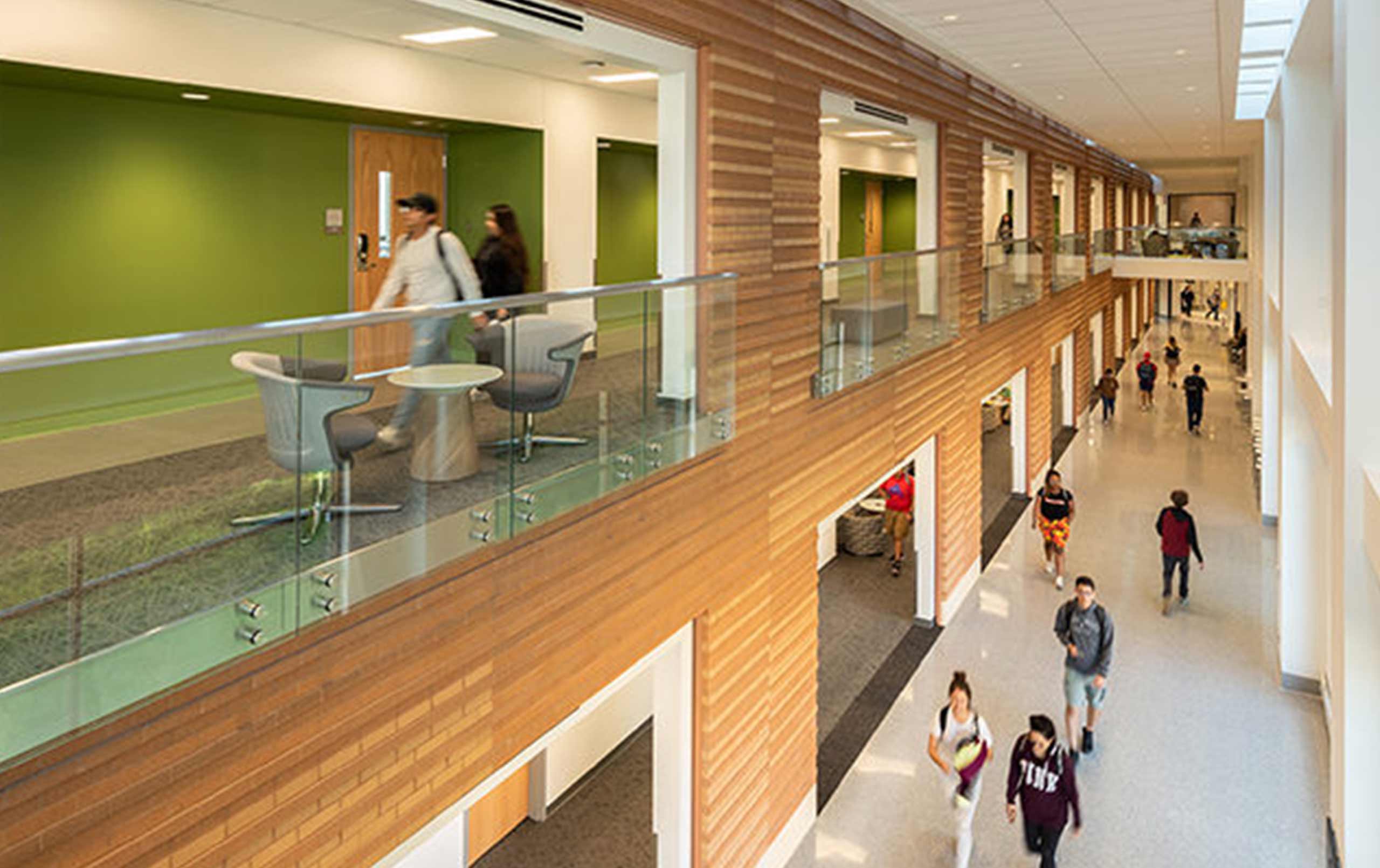
Tomorrow’s scientists, engineers, and technicians get a solid foundation at CLC Science and Engineering Building, which achieves LEED Platinum certification, the U.S. Green Building Council’s highest rating for sustainability and energy efficiency.
When visitors enter the newest building on the College of Lake County’s (CLC) Grayslake, Illinois campus, one of the first spaces they see is a first-floor mechatronics lab in which future technicians study the operation of mechanical systems, electronics, pneumatics, and even robotics. Next door in the laser, photonics, and optics labs, students studying to be optics technicians or systems installers measure light wavelengths and use lasers to cut metal. On the second and third floors, students study in living room-like gathering areas or run chemistry experiments in light-filled labs with energy-efficient fume hood systems.
In the 42,000-square-foot Science and Engineering Building, designed by longtime CLC partners Legat Architects and Brubaker Design, students prepare for career paths ranging from chemistry and biomedical engineering to alternative energy, manufacturing, and aerospace.
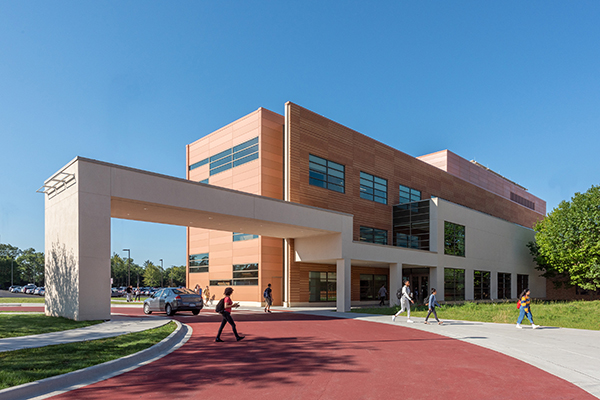
The Science and Engineering Building also stands as the second community college building in Illinois to achieve LEED Platinum certification, the U.S. Green Building Council’s (USGBC) highest rating for sustainability and energy efficiency (the first was Moraine Valley Community College’s Southwest Education Center, also designed by Legat). From the 47 geothermal wells extending 500 feet into the earth to the 187 photovoltaic panels that top its roof, the building is outfitted to reduce building energy use to the tune of 66% compared to a standard science building of similar size.
The new building not only expands CLC’s science and engineering programs to several times their former size, but it also creates a new south entry adjacent to 60% of the campus parking. Its canopied entrance and two-story atrium present a much different first impression than before, when many students entered through a side entrance.
“The Science and Engineering Building is a new commons space with plenty of gathering areas,” said Bruce Locke, retired senior project manager with the Illinois Capital Development Board (CDB), which managed and helped fund the project. “It also creates a buzz to attract students who might be interested in the programs it houses.”
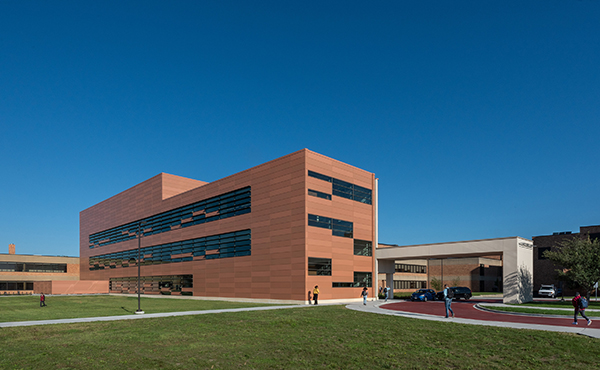
LEED Platinum Achievement Reinforces CLC’s Longstanding Sustainability Leadership
In recent years, CLC has earned a reputation for its leadership in sustainable practices—the college received major awards from the Illinois Sustainable Technology Center and the USGBC Illinois chapter. It also ranks in the top ten U.S. community colleges in the Association for the Advancement of Sustainability in Higher Education’s (AASHE) 2018 Sustainable Campus Index.
The Science and Engineering Building, CLC’s first LEED Platinum building, has become an embodiment of the college’s commitment to sustainability and integration of environmental awareness in academic programs. According to the USGBC’s current database, the facility’s 90 points make it the highest-scoring LEED BD+C (New Construction and Major Renovation) certified facility in Illinois and one of top 4 highest-scoring LEED projects in the Midwest.
Among its sustainable features are photovoltaic panels, green roofs, a geothermal heating and cooling system, a rainwater recovery system (collects rain in underground tank and uses it for flushing of toilets and urinals), LED lighting, a daylight harvesting system, and energy-efficient fume hoods.
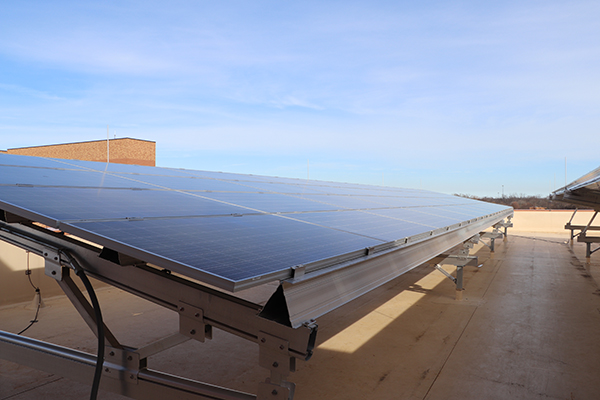
Before construction, Affiliated Engineers Inc. (AEI) did an energy model that assessed energy conservation measures and their impact on annual energy use and cost. One result of that study is the south façade with its large windows that provide the appropriate amount of daylight into the labs.
The entire building and most of its interior were analyzed to optimize daylighting, reduce glare, and improve thermal performance. The most interesting and not so obvious element is the self-shading façade concept developed by Legat as early as 2008. The shading solution uses extended mullion caps to control light, heat, and glare at virtually no additional cost, and helps fill the academic spaces with an abundance of natural light.
Legat’s Jeffrey Sronkoski, principal and director of higher education, said, “From the very onset of the project, the college’s leaders were intent on making the Science and Engineering Building a model of sustainability. Not only did they accomplish their objective, but they also showed that achieving LEED Platinum for science buildings is no longer the holy grail it once was.”
The team recognized that, in order to attain LEED Platinum for a lab building, an east/west orientation was a must to respond to the sun’s seasonal changes in elevation. When the sun is higher in summer, the exterior shades above the windows act like visors and prevent sunlight from hitting windows to reduce solar heat gain. In winter, labs get solar heat gain because the lower sun shines beneath the shades.
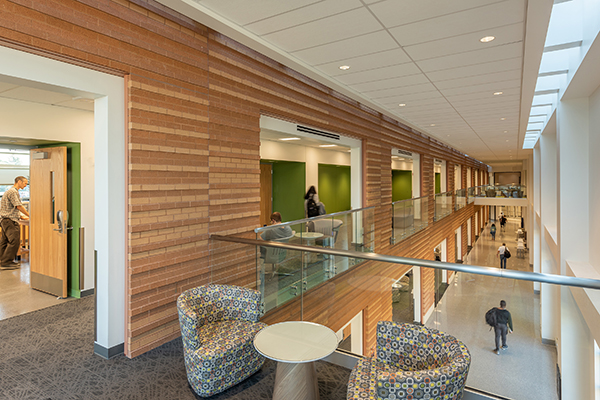
All in the Same Family: Brick Feature Wall
One design challenge was getting the Science and Engineering Building to aesthetically blend with the brick-dominated CLC campus, while avoiding a complete brick building due to the high cost. Part of the solution came in the tri-colored metal panels that dominate the building’s exterior and mimic the three brick tones of the existing building.
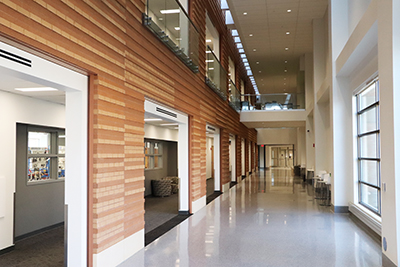
A brick feature wall starts outside the entry and runs the length of the two-story atrium, where it frames the labs. The 238-foot-long wall uses three colors in six new patterns to reflect the existing campus. Thus, the 1970 original building, a Legat-designed 1985 addition, and the Science and Engineering Building all appear to be in the same family.
Most other walls within the atrium are painted a neutral white to bounce light around and keep the focus on the brick wall, while walls within the corridors each have an earth-oriented accent color: orange-brown on the first floor, green on the second, and blue on the third.
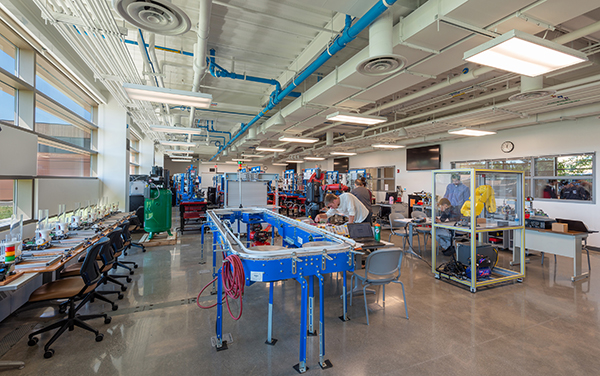
Mechatronics: A Growing Industry
The first-floor mechatronics lab in the Science and Engineering Building is a haven of circuitry, gears, and gadgets. Here students learn about Programmable Logic Controllers (PLCs), the industrial computers used to control the complex assembly line and robotic systems at manufacturing plants. Among the mechatronics lab equipment are trainers with mechanical and electrical controls, robots, belt/chain/gear drives, and pneumatic air circuits.
Mechatronics instructor Dr. Margie Porter said that mechatronics is a multidisciplinary program that touches everything from the smart sensors found in automatic handwashing stations and soda machines to the Mars rover. The demand for PLC expertise is strong, she said, with baby boomer programmers retiring to the tune of 10,000 a day.
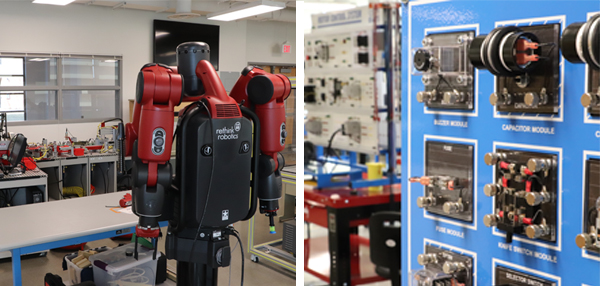
Previously, CLC’s mechatronics program housed 16 trainers in one small room and 12 trainers in an even smaller room within the Technology Building. “The trainers were literally back to back and cords were everywhere,” said Porter. “There was little room to move around and it was hard to get from student to student.” Additionally, a lack of air lines and outlets restricted the trainers to the same spot.
At three times the size of its predecessor, the new mechatronics lab allows the wheeled trainers to be moved throughout the space. Porter said, “We can completely rearrange the room in no time and hook up the trainers anywhere because of the abundance of air lines and outlets in the floor.”
Also new to the mechatronics lab are large exterior windows that bring in daylight, as well as interior windows that display lab activity to students passing in the corridor. According to Porter, the corridor window has generated a great deal of interest in the program.
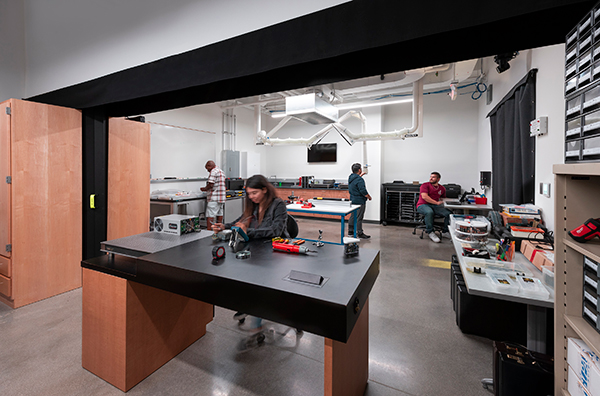
Lasers/Photonics/Optics: Keeping Up with Demand
Nine years ago, CLC launched its Laser/Photonics/Optics (LPO) program on the second floor of its Technology Building. When its Associate in Applied Science degree received approval, LPO moved into one room at the Lake County Tech Campus (adjacent to CLC’s campus) and opened the program to high school students.
Bill Kellerhals, LPO program chair and instructor, said that nothing in the old space was designed for the program’s complex laser equipment, much of which was crammed in a temporary storage area that students called “the dungeon.”
Then there was the challenge of demonstrating the LPO program elsewhere on campus. Kellerhals and students had to wheel equipment across campus, then up and down floors. Once it arrived, the equipment took an hour to set up and another 45 minutes to take down.
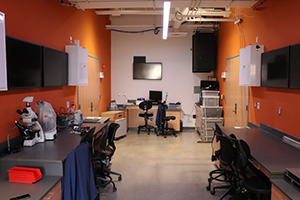
Today, the LPO program has its own space in the new Science and Engineering Building. A mission control zone offers access to four labs: intro optics and laser, electrical, high-power laser, and advanced electro-optic devices. Multiple labs (versus one room) enable Kellerhals to separate equipment and teach multiple topics simultaneously.
Additionally, there’s no more lugging equipment back and forth. Kellerhals said, “When we need to give a demonstration, guests just come into our space and things are pretty much ready to go.”
Students who pass through the LPO program get a baseline optics experience by using multispectral lasers that produce different wavelengths—one laser even cuts through metal. Eventually, they will pursue careers as photonics systems technicians who repair and operate electronic and electromechanical devices. They can apply their skills to a wide variety of fields: aerospace technology, agriculture, biomedicine, construction, alternate energy, global positioning, homeland security, manufacturing, and more. Products that they work with range from autonomous vehicles to the tiny lenses that attach to endoscopes.
Kellerhals, a retired Navy commander and nuclear engineer who worked on submarines for 23 years, said that demand exceeds supply for technicians graduating from two-year college programs in optics, photonics, and related industries. The demand is particularly intense in the manufacturing and medical arenas. He said, “The technology keeps advancing, creating a higher level of skills needed across these sectors. There’s nobody in the pipeline to take over.”
According to the National Center for Optics and Photonics Education, photonics is an “enabling” technology, meaning that what students learn in these courses can be applied to other postsecondary programs and give them access to a wide variety of jobs. Consequently, the LPO labs in the CLC Science and Engineering Building are located next to the mechatronics labs. The coursework often overlaps between the programs.
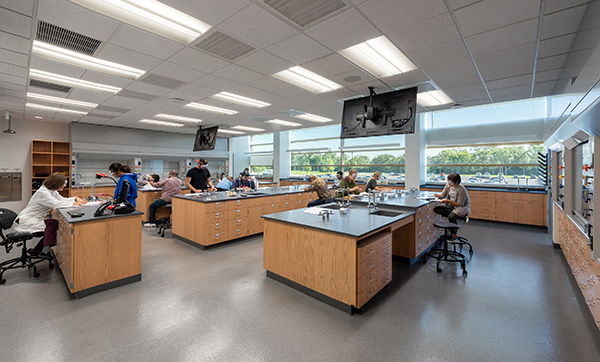
Chemistry: Space, Light, and Storage
The four chemistry labs on CLC’s main campus had not received major updates since the science wing was built in 1985.
Dave Wentzell, laboratory and chemical hygiene supervisor of CLC’s Biological & Health Sciences division, said, “The labs were too small and not up to snuff with current advances.” A cost-benefit analysis revealed that upgrading the old labs would be too costly.
The new Science and Engineering Building houses two labs on the second floor and three labs on the third floor. Most new labs are at least twice as large as the old ones. Interspersed between the main labs are teaching labs, prep space, and a chemical storage room.
In addition to their size, one of the most striking aspects of the new labs is the abundance of daylight—a big change from the previous labs, which were surrounded by other rooms and therefore had no windows to the outside.
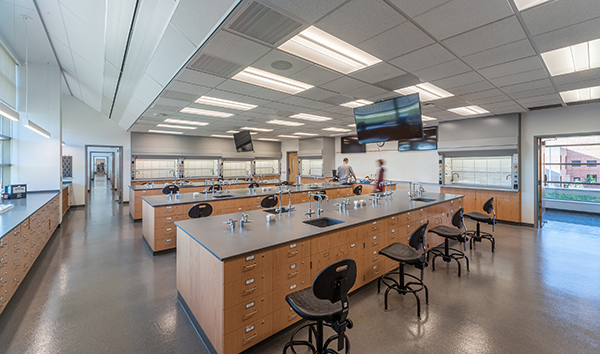
Scot Parker, Legat principal and project manager, said, “We wanted to bring as much natural light into the space as possible.”
Raised and sloped ceilings maximize the light coming in from the 10-foot-tall window systems along the south wall. To further soften the labs, Parker and team specified gray countertops, lighter color wood casework, and gray epoxy flooring instead of the darker options that are more common.
“The labs feel brighter and don’t have the dark, drab, industrial feel of utilitarian labs,” said Wentzell. “Faculty and students have mentioned that working in the new labs improves their mood and makes being in the spaces a much more pleasant experience.”
With his focus on lab safety, Wentzell was also heavily involved with planning the chemical storage spaces. Prior to the Science and Engineering Building, storage was relegated to a small converted space. Ventilation and temperature control were a constant source of concern.
The Science and Engineering Building offers several rooms designed specifically for storage. Chemicals get stored in ventilated cabinets both above and below counters.
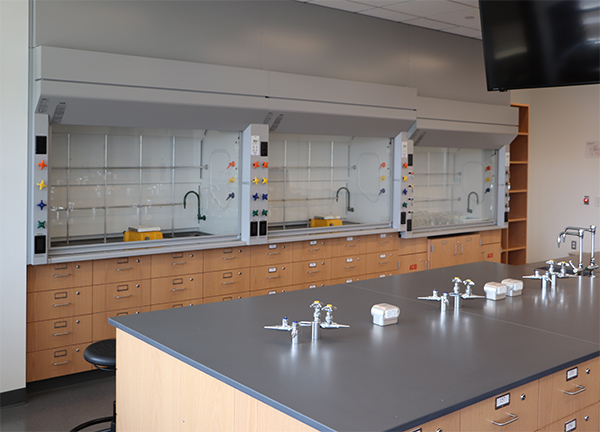
Energy-efficient Fume Hood System
Ask a CLC science student the biggest difference between the old and new labs. The answer is likely to be the quality and number of fume hoods, which expel hazardous fumes. Whereas most old labs had three or four fume hoods, labs in the Science and Engineering Building have between six and ten for a total of 42 in the facility.
The fume hoods in the new building also conserve energy. Typical fume hoods run at full capacity 24-7. They expend a great deal of energy pumping air out of the facility and take a hefty toll on operational costs. The energy-efficient systems within the Science and Engineering Building, however, operate on the premise that if you’re not working with experiments involving fume hoods, then they don’t need to be running at full throttle.
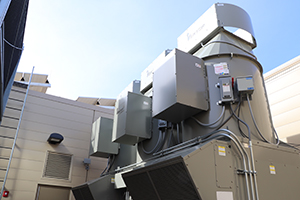
Unlike traditional constant air volume systems, variable air volume fume hood systems, like those at CLC, power down when the units are not in use. A sensor measures the openness of the sash window and tells the unit how much air it needs to draw. The units communicate with a massive exhaust system with three separate fans on the roof. When hoods are closed, the fans slow to a minimum setting as opposed to the standard fume hood fan that never slows down.
Scott Foster, project manager with AEI, said, “With variable air volume, the fans only put in and take out as much air as needed. The fans still operate at a safe exit velocity, but they reduce energy demands and lower sound.”
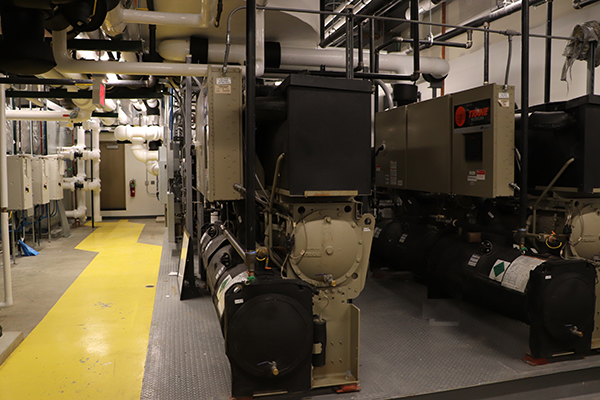
Behind the Scenes: Mechanical Penthouse
The fourth-floor mechanical penthouse features a pre-manufactured skid that provides heating and cooling water to the Science and Engineering Building. Typically, the pumps, chillers, and piping associated with this system are brought separately and assembled at the project site. However, all pre-manufactured skid elements are engineered and constructed in a factory, then one large unit gets delivered on a truck.
In the case of this new building, the compact nature of the skid resulted in space savings. The skid also saved construction time since it was built at the same time as the building’s shell. Once the penthouse was ready, the skid merely had to be shipped and connected to building piping and electrical.
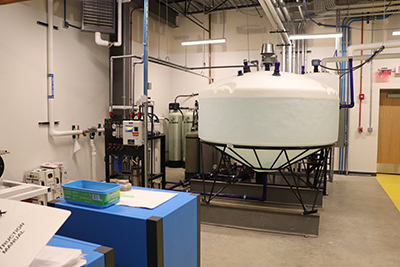
The building’s photovoltaic and geothermal systems also run through the mechanical suite. The geothermal system, designed by AEI, connects to 47 wells buried 500 feet below ground. It draws from the earth’s constant temperature to provide 90% of the building’s heating and cooling load, thereby significantly decreasing energy costs. Another highlight of the penthouse is a giant basin that stores 1,000 gallons of high-purity water that goes directly to the labs.
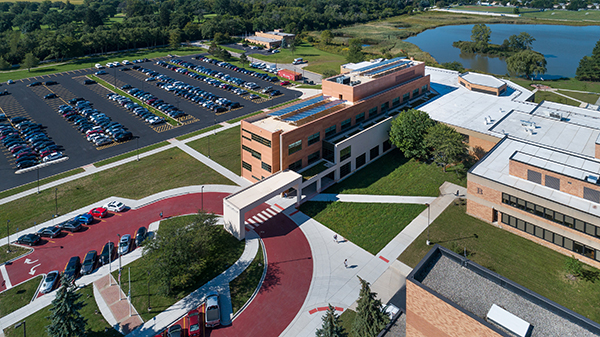
Slim Footprint, Wide Influence
Seen from above, the Science and Engineering Building appears as a slim volume that extends east and west at the south end of CLC’s campus. However, within its walls are modern technical spaces that pave the way for CLC’s curriculum to expand into the emerging sciences. Whether they’re using beakers and Bunsen burners or lasers and robots, students get the training needed to pursue respected technical careers.
Moreover, despite being a facility type (i.e., higher education science) notorious for heavy energy consumption, the Science and Engineering Building transcends this label to become a model for energy efficiency.
Contact us to learn more about science facility and higher education design or comment below to share your thoughts on this post.


